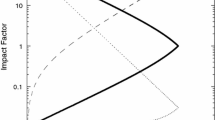Abstract
If f(r) is the number of contributions of an author or rank r, then it is shown that f(r) is proportional to r−β, where β>0. The model is dependent on the definitions of “a contribution” and “rank” of an author. Three estimation procedures are illustrated and four other scientific productivity studies and two data sets on Canadian Mathematicians are shown to adequately fit this rank-frequency relationship.
Similar content being viewed by others
References
H. VOOS, Lotka and Information Science,Journal of the American Society for Information Science, 25 (1974) (No. 4), 270–2
L. J. MURPHY, Lotka's law in the humanities?,Journal of the American Society for Information Science, 24, (1973) 461–2.
D. H. LEAVENS, Letter to editor,Econometrica, 21, (1953) 630–2.
J. DUFRENOY, The publishing behavior of biologists,Quarterly Review of Biology, 13, (1938) 207–10.
A. J. LOTKA, The frequency distribution of scientific productivity,Journal of the Washington Academy of Sciences, 16, (1926) 317–23.
A. DRESDEN, A report on the scientific work of the Chicago section, 1897–1922.Bulletin of the American Mathematical Society, 28, (1922) 303–7.
H. A. SIMON, On a class of skew distribution functions,Biometrika, 42, (1955) 425–40.
N. R. DRAPER, H. SMITH.Applied Regression Analysis, Wiley, New York, (1966).
W. AUERBACH,Geschichtstafeln der Physik, Barth, Leipzig, (1910).
H. T. DAVIS, The analysis of economic time series,Cowles Commission for the Research in Economics, Monograph No. 6 (1941).
R. C. COILE, Lotka and Information Science,Journal of the American Societu for Information Science, 26, (1975) (No. 2), 133–4.
J. VLACHÝ, Time factor in Lotka's Law,Probleme de Informare si Documentare, 10, (1976) (No. 2), 44–85.
J. VLACHÝ, Distribution patterns in creative communitiesContributed paper for the 8th World Congress of Sociology, Toronto, 1974, Aug (p. 20).
J. VLACHÝ, Population output of European Physics,Czech. Journal of Physics, B29, (1979) 237–244.
Author information
Authors and Affiliations
Additional information
Research partially supported by National Research Council Grant No. A9229.
Rights and permissions
About this article
Cite this article
Hubert, J.J. A rank-frequency model for scientific productivity. Scientometrics 3, 191–202 (1981). https://doi.org/10.1007/BF02101665
Received:
Issue Date:
DOI: https://doi.org/10.1007/BF02101665




